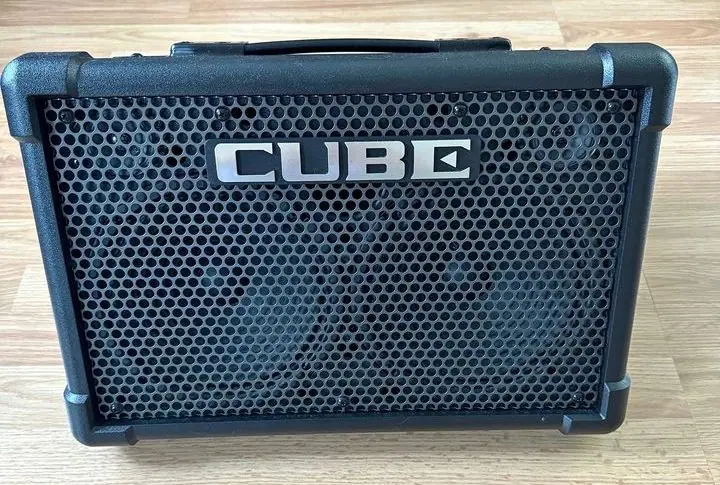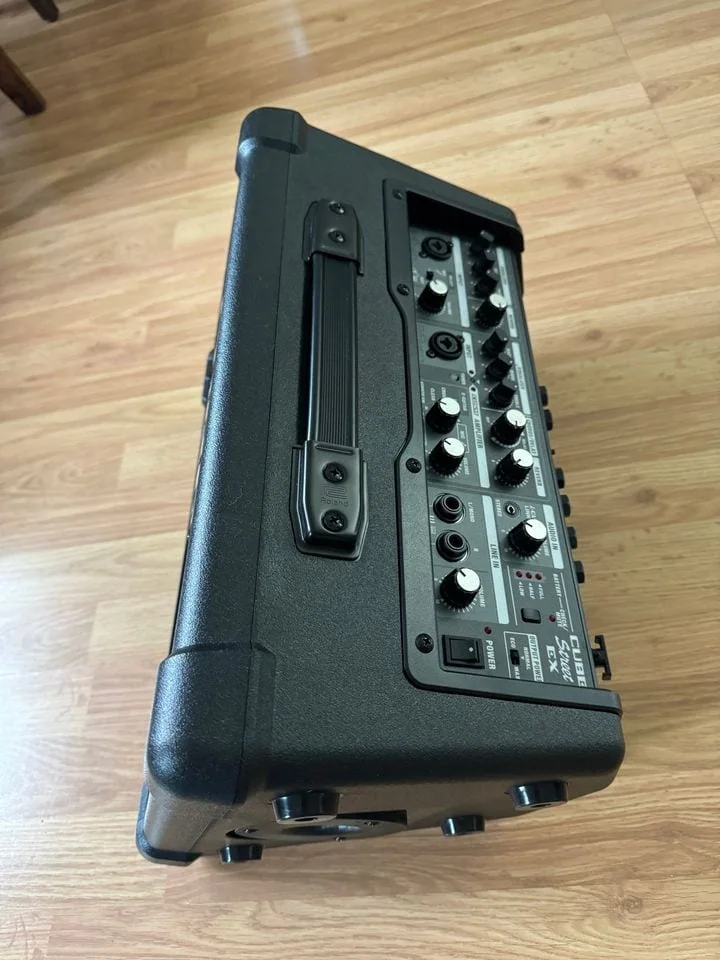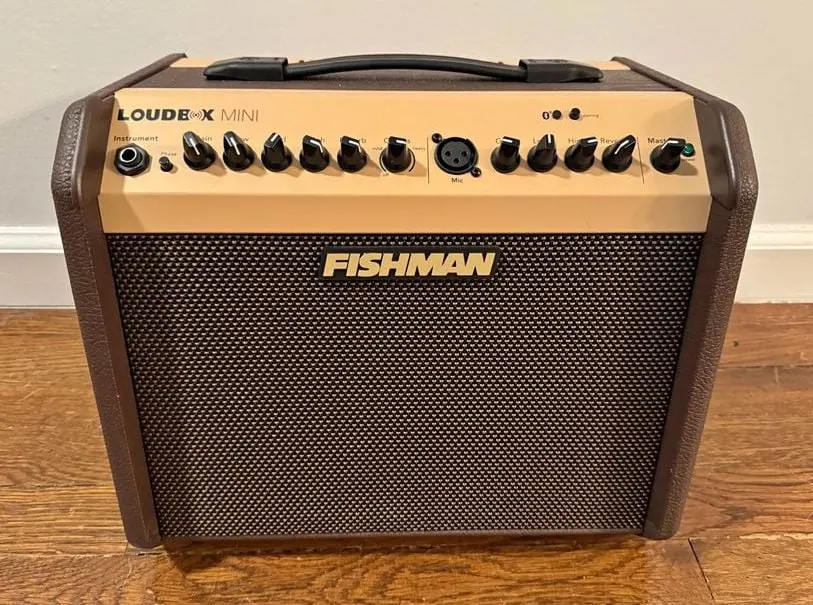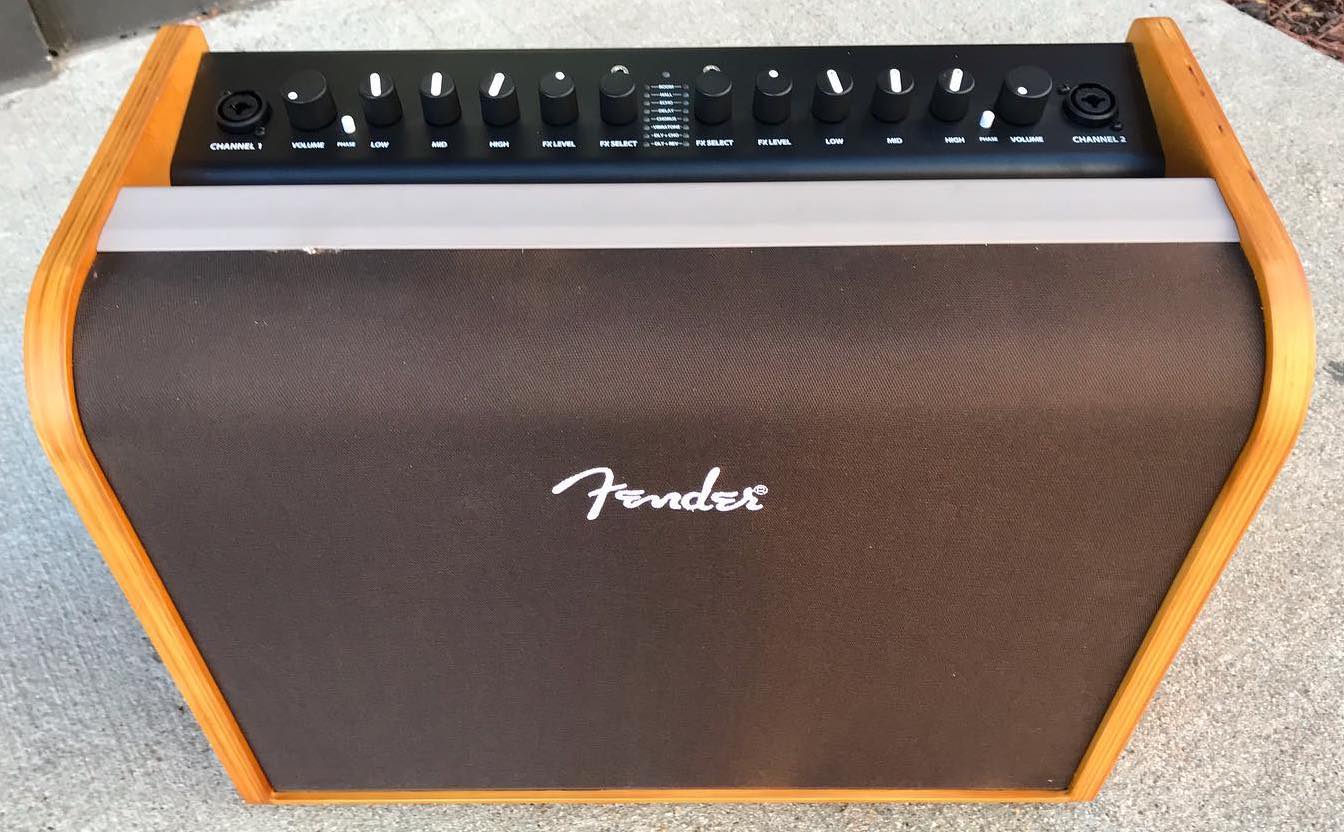The best vocal amps reproduce a singer’s voice with sparkling clarity while providing plenty of adjustable, onboard controls. They need to be both portable and powerful enough to project vocals for live performance.
Top 3 - Vocal Amps for Singers
Preview | Product | Price |
|---|---|---|
Ideally, a high-quality vocal amp or PA speaker also requires some built-in effects such as reverb and delay. In this detailed guide, you’ll find the very best amplifiers and speakers for vocals so that you can decide which one best suits your needs.
Best Vocal Amps for Singers (Including PA Speakers)
1. Boss Acoustic Singer Live LT
When it comes to cool little amps, few are cooler than Boss’ Acoustic Singer Live LT. This amp combines both a vocal amp and a guitar amp into one neat unit.

The Acoustic Singer Live LT offers extensive tonal controls.
The Acoustic Singer is a 2-channel amp. But where most 2-channel amps might have minimal features for both channels or some features reserved for one channel, the Acoustic Singer does things differently.
Both channels are fully stacked and equipped with Volume, 3-band EQ, and Reverb controls. Both channels also feature a very handy Anti-Feedback control, especially useful for singers.
The channels only have one difference. The mic channel has a Delay/Echo control and the guitar channel has a Chorus that can switch between two types.
The amp also has a basic Looper and Harmonizer. You won’t be making complex loops and harmonies, but you can still do some interesting things with the limited control on offer.
The Acoustic Singer has a few other conveniences that I really like. The cabinet is slightly tilted, so the sound is more direct towards you for better hearing.
There is also a DI/Mix input at the back. This lets you hook up a small mixing desk for easy control within arm’s reach.
Apart from all these great features, the amp also sounds great. Vocals and guitar sound full and clear. And there isn’t any bleed or other audio issues when both channels are being used.
Of course, as the name might suggest, the Acoustic Singer is really only meant for acoustic guitars. You might be able to play an electric clean through the amp, but for the best experience, I would stick to an acoustic.
While the amp is fairly loud, it is really only suited for smaller performances. You won’t be playing any clubs with this amp, but cafés and busking on the street are right up its alley.
PROS
CONS
2. Roland CUBE Street EX
As the name might suggest, the Roland CUBE Street EX is meant to be used on the streets. This little amp is a busker’s dream.

The CUBE Street EX is kitted with all the basic features you will need for both vocals and guitar. Both channels have a full 3-band EQ and Reverb, and the mic/guitar channel also has a Chorus/Delay.

Roland CUBE Street EX Controls
The amp is not limited to just acoustic guitars. The guitar channel can be set to either acoustic or electric. There are four settings for electric: Acoustic Sim, Clean, Crunch, and Lead.
The crunch and lead settings are certainly nowhere near as great as what you would find on a guitar amp. But I think they are fine enough for busking and it does help a bit to reduce the amount of gear you need to carry around.
The amp sounds great, though. Both guitar and vocals are clear and have a lovely fullness. Other instruments, like keyboards, sound just as great, and I had no issues plugging in my phone or any other devices to play backtracks.
The CUBE Street is also more than loud enough. At 50 watts you are going to stand out while busking on the street.
Speaking of busking, the CUBE Street can run off of both wall power and battery power. My only issue is that it takes eight AA batteries.
Not only does this mean that you need a bunch of batteries to power it, but you will probably also have to carry around a bunch of spares. Battery drain is also a concern with AA batteries.
Luckily, you don’t have to run the amp at its full 50-watt output the whole time. The amp can also run at 25 or 10 watts. Which is good to make your batteries run longer, but you might also be in situations where you need to play at lower volumes.
The CUBE Street is sadly rather limited to being a busking-only amp. And that does make the price also seem a bit steep.
PROS
CONS
3. Samson Expedition XP106w
The Samson Expedition XP106w is an impressive piece of equipment considering its size. It does more than some speakers twice its size and three times its price tag.

At 100 watts, the XP106w has quite a lot of volume. Barbecues, big birthdays, a small gig, this speaker can handle almost anything you throw at it.
Not only is it loud, but it sounds great as well. The sound is fairly well-rounded. The highs are nice and chimey and the bass is punchy. Although, the bass is certainly more heard than felt.
For me, though, where the XP106w really shines is in its features. It can run on both wall power and battery power. Making it highly portable and you never have to worry about whether or not there will be a power outlet to plug it into.
But the coolest feature is definitely the 4-channel mixer at the back of the speaker. Each channel only has an independent volume control, but that is still more than many other speakers.
This lets you adjust the volume for your mic separately from the volume of say your keyboard or MP3 player. So, you can make sure that your instrument or backing track isn’t louder than your vocals, and everything is clearly audible.
The four channels also allow you to have multiple sources playing at the same time. You can sing and play keyboard while having a backtrack play all at the same time.
The fourth channel is also dedicated to Bluetooth devices. This lets you split instruments and backtracks between two channels so that they can be mixed independently.
The XP106w has a neat little feature for switching between music and speech. You simply press a button to switch between the two modes. All this does is cut the bass a bit, but makes speech much clearer for speaking engagements.
The XP106w is a fantastic speaker for any singer/musician. Being able to run on battery power also makes it perfect for busking.
The only weakness is the included wireless mic. It is pretty cheap and not the greatest mic, but it comes free with the XP106w and you can just use a better mic.
PROS
CONS
4. Fishman Loudbox Mini BT
Fishman are best known for their acoustic pickups and amplifiers. The Loudbox Mini is another Fishman entry with a convenient XLR input for a microphone.
The first thing you notice is the Loudbox Mini’s volume. As the name implies, it offers plenty of clean headroom and oomph for playing smaller venues. It also has a convenient DI output, so theoretically you could run it into a larger PA if need be.
The Loudbox is also packed with features, including onboard effects (chorus, reverb, and phase), a nicely sensitive EQ, and an aux input so you can play background music in between sets.

The Fishman Loudbox Mini BT - a personal favorite of mine!
The amp only weighs about twenty pounds, so you can walk into a venue with your guitar in one hand and the Loudbox in the other.
One drawback of using an acoustic amp like this as a vocal amp is that you’ll need to mount it on a chair or amp stand. If you leave the amp on the floor (as you would a normal guitar amplifier) your voice will just hit the tables and chairs.
However, overall, the Fishman offers excellent quality of sound. Chords sound robust and full. Single-string runs have sparkle and shine. The speaker provides plenty of vocal clarity, too, with none of the honk or sizzle that some guitar amps have when you sing through them.
PROS
CONS
5. Fender Acoustic 100
Fender has been churning out some excellent amps and acoustic instruments recently, so it’s no surprise that the Acoustic 100 is another solid entry from the American guitar giant.

First of all, the amplifier’s brown cloth and plywood sides really catch the eye. This is a gorgeous amplifier that carries Leo Fender’s design legacy with aplomb.
Fender’s electric guitar amps are infamously dense and heavy, but that’s not the case here. This acoustic amp weighs in at under twenty pounds.
However, the lack of a handle (or handles) makes carrying the Acoustic 100 into a gig easier said than done. I prefer to walk into a gig with a guitar in one hand and something else in the other, and this is unfortunately a two-hand job.
However, the Fender Acoustic 100 sounds excellent. Acoustic guitar chords ring out and sparkle. Even a voice as loud as mine doesn’t distort through the speaker. It offers 100 watts of volume, so you can definitely fill the local coffeehouse.
However, the 8-inch Whizzer speaker leaves a little to be desired. It sounds good, but lacks the distinctive character and extra oomph that a larger speaker array might offer.
PROS
CONS
6. JBL EON715
JBL has been around for a long time and they make some of the highest quality speakers around. They are considered to be among the industry standards.
The EON715 is no different. It is an excellently crafted speaker that packs a lot of power.
By a lot of power, I mean a lot of power. The EON715 is a massive 1300 watts. This thing is going to fill practically any space you put it in.
All this power does mean that it is a professional-level piece of equipment. This speaker is meant to be used at big events. Large concerts, big corporate events, etc.
That doesn’t mean you won’t be able to use it at smaller events. It can get pretty quiet, but it shines the most at higher volumes.
All of this power means nothing if the speaker doesn’t sound good, though. Generally, if you hear the name JBL you can almost be assured that it sounds great. And the EON715 sounds great.
The speaker is very responsive, with a ton of low end, great highs, and a very punchy midrange. No matter what you’re pushing through the speaker, vocals, instruments, everything sounds great.
The EON715 has a great set of features as well. It has two mic/line channels, each with dedicated volume control, along with a master volume.
There are also four EQ presets Main, Monitor, Sub, and Speech. So, depending on what you are using the speaker for, you can set it to the preset that will make it sound the best. It also has Bluetooth connectivity (latest Bluetooth 5.0 for low-energy operation) for wireless operation.
The EON715 isn’t the most portable speaker, however. It is quite a big unit and isn’t lightweight at all. You probably won’t be carrying it around with one hand (at least I couldn't when I tried) and you will need to make some extra space in your car to take it to gigs.

The EON715 is one hefty piece of gear!
But apart from that, the EON715 is a fantastic speaker and excellent value for money.
PROS
CONS
7. Pignose Amps LTD Edition
The Pignose Amps LTD Edition is quite the unique little amp. From the way it looks to its sound, everything about this amp is special.
The LTD Edition probably doesn’t look like any other amp you have ever seen. It very much looks like it was made in the 1940s. The tweed cover cab, small round mesh face, and single, oversized volume knob. This amp just oozes style.
But don’t let its small size mislead you. Even though it only comes in at 5 watts, the LTD is still quite the loud little amp. You won’t be filling stadiums or even clubs with its volume, but it is more than enough to be noticed.

This Pignose amp is unlike anything else I've talked about here.
It also sounds great. The LTD has a very chimey, twangy, vintage sound. You also have the ability to change the sound quite a bit.
The LTD has a very unique design where you can open the entire case up, just like a briefcase. This means you can change the LTD from being a closed back to an open back amp. So, depending on how bassy you want the amp to be, you can just open it up to 180 degrees.
Its small size also makes it very portable. You can carry the LTD around with ease, or even strap it around your shoulder and barely notice that it’s there.
It does have some significant downsides in my opinion. Controls are very limited. The LTD only has a volume control. So no EQ, no clean or gain channels, no effects. The LTD is a pure plug-and-play amp.
And of course, there is the power. While it is quite loud for a 5-watt amp, it still leaves a whole lot to be desired. You will only be practicing or busking with the LTD, and only if there are no other loud sounds nearby to drown it out.
PROS
CONS
Useful Features on Vocal Amps
There are several main qualities to look for when choosing the best vocal amplifier for your requirements. Indeed, clarity, volume, and tone are the first three that spring to mind.
Along with these foundational qualities, it’s important to choose an amp that offers the processing options that you need. Onboard EQ units allow you to tailor the frequency response of the amp or speaker to suit your voice.
Effects such as reverbs and delays are also commonly included. If you prefer a clean tone, then these aren’t essential, but if you like to soften your vocals with reverb or make them sound more ambient using delay, you should choose one that provides these options.
What to Look for in a Vocal Amp or Speaker
After going through this list you might still be a little unsure about which vocal amp to choose. Well, there are a few things you can consider when making your choice that can help narrow down your options.
Sound Quality
Of course, the most important thing to consider when choosing an amp is its sound. Not only is that what you are going to hear, but other people as well. Your amp can have all the bells and whistles, but that means nothing when the amp doesn’t sound good as well.
This is especially important if you are planning on using your amp for both vocals and instruments or backing tracks. Not only do both need to sound good separately, but they need to still sound good when played together.
Nothing is more distracting than your vocals sounding great, but your guitar sounds muffled or too soft. So, when you are choosing an amp, always test it out in a way that resembles how you are actually going to use it.
Controls and Effects
Another very important thing to consider is the controls on the amp. For me, having good EQ controls is the most important.
This allows you to make fine adjustments to your sound to shape it. And considering that everyone’s voice is completely different, you need to be able to shape your sound.
Some people have very bassy voices, in which case you want to reduce the amount of low-end your amp and turn up the treble a bit. Someone with a higher pitch voice would need to do the opposite, turn up the low-end and turn down the highs. I always try to go with an amp with a full 3-band EQ for the most control.
If you are using the amp as both a vocal and instrument amp, having both separate EQ and volume controls is also important. The EQ controls so that you can shape the sounds independently. And volume to make sure both vocals and instruments are even and neither drowns out the other.
And then lastly, effects. While not necessarily as important, having built-in delay, reverb, chorus, etc. can really help to add some color to your singing.
Durability
This is just an important thing in general. You want your equipment to last as long as possible.
But I would try to get the most durable amp possible. Especially if you transport your amp often, and certainly if you are going to use your amp for busking.
You want an amp that can take a beating and still perform. Amps are expensive pieces of gear, and the last thing you want is to have to replace your amp every few months.
Portability
This depends quite a bit on your use case. But the portability of your amp should be taken into consideration.
Heavier amps can be a hassle if you are taking it to and from gigs on a regular basis. Try to find an amp that you won’t have any issues carrying by yourself, and preferably with one hand to cut down on trips to the car.
Amps that can run on battery power are also great when it comes to portability. If you are planning on using your amp for busking, then you should make sure your amp can run on batteries.
Not every place you go to will have power outlets and I have heard that there are many places that charge for using power or just outright refuse. Batteries are also much more convenient than carrying around leads or small generators/power banks.
Price
The amount you spend on your amp is really going to be determined by what you can afford. I do believe, however, that you don’t need the most expensive amp, especially not for singing.
Even cheaper amps can still sound great and you don’t necessarily need a thousand-dollar amp to have your voice still sound great. Not only that, but you probably also don’t want to carry around an expensive amp, particularly if you are using it for busking.
Try to strike a balance between performance, features, and price. And test out a few cheaper amps before you just jump straight to the high-end models.
Final Word
Investing in a good quality amplifier or PA speaker for vocals is a very wise move indeed.
Too often vocal amplifiers get overlooked in comparison to instrument amps. Choosing the right one for your style will help to get the very best out of your voice in a live setting.









Hello Dedrich!
Thank you for your articleS.
I recently purchased the Ditto Mic Looper which you recommended in another article, and now I need to buy a vocal amplifier. Would you recommend a specific one to go with the Ditto Mic Looper?
PS: I’m a beginner and I’m not ready to make a big investment yet.
Are any of these amps or speakers good for harmonica ( blues harmonica)? If not can you recommend any?